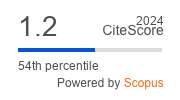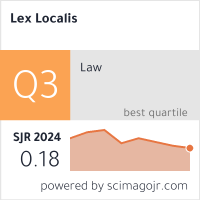Development Impact Fees: A Vehicle or Restraint for Land Development?
DOI:
https://doi.org/10.4335/13.3.1047-1065(2015)Keywords:
development impact fees, land development, growth management, uncertainty, Florida countiesAbstract
Although development impact fees have been used by local governments for decades, it is still not well understood how this tool serves its fundamental policy goal of growth management. Previous studies have shown that impact fees can serve as either a vehicle or restraint for land development. By using panel data from Florida counties in the U.S., this study shows that the use of impact fees precipitates local development by increasing the value of developable parcels. Impact fees allow developers to pursue more development activities as they bear the imposed fees.
References
<p align="justify"><span lang="EN-US" style="font-size: 13px; font-family: Cambria">Altshuler A. A. & Gomez-Ibanez, J. A. (1993) Regulation for revenue: The political economy of land use exactions (Washington DC: Brookings Institution Press).
Been, V. (2005) Impact fees and housing affordability, Cityscape: A Journal of Policy Development and Research, 8(1), pp. 139-185.
Benton, J. E. (2002) County service delivery: Does government structure matter?, Public Administration Review, 62(4), pp. 471-479.
Benton, J. E. (2003) County government structure and county revenue policy: What’s the connection?, State and Local Government Review, 35(2), pp. 78-89.
Blaesser, B. & Kentopp, C. M. (1990) Impact fees: The second generation, Washington University Journal of Urban and Contemporary Law, 38, pp. 55-100.
Brueckner, J. K. (1997) Infrastructure financing and urban development: The economics of impact fees, Journal of Public Economics, 66(3), pp. 383-407.
Burge, G. & Ihlanfeldt, K. (2006a) The effects of impact fees on multifamily housing construction, Journal of Regional Science, 46(1), pp. 5-23.
Burge, G. & Ihlanfeldt, K. (2006b) Impact fees and single-family home construction, Journal of Urban Economics, 60(2), pp. 284-306.
Burge, G. & Ihlanfeldt, K. (2007) Documenting the rise of impact fees in Florida, In: Connerly, C. E., Chapin, T. S. & Higgins, H. T. (eds) Growth management in Florida: Planning for paradise (Burlington, VT: Ashgate Publishing), pp. 283-304.
Burge, G. & Ihlanfeldt, K. (2009) Development impact fees and employment, Regional Science and Urban Economics, 39(1), pp. 54-62.
Campbell, D. (2006) Impact fee competition: Dynamics among counties in Florida, Working paper (Atlanta, GA: Georgia State University).
Cho, S., Kim, S. & Roberts, R. K. (2009) Measuring the effects of a land value tax on land development, Applied Spatial Analysis and Policy, 4(1), pp. 45-64.
Cho, S. & Newman, D. H. (2005) Spatial analysis of rural land development, Forest Policy and Economics, 7, pp. 732-744.
Cho, S., Chen, Z., Yen, S. T. & Eastwood, D. B. (2006) Estimating effects of an urban growth boundary on land development, Journal of Agriculture and Applies Economics, 38(2), pp. 287-298.
Clarke, W. & Evans, J. (1999) Development impact fees and the acquisition of infrastructure, Journal of Urban Affairs, 21(3), pp. 281-288.
Delaney, C. J. & Smith, M. T. (1989) Impact fees and the price of new housing: An empirical study, AREUEA Journal, 17(1), pp. 41-54.
Drukker, D. M. (2003) Testing for serial correlation in linear panel-data models, The Stata Journal, 3(2), pp. 168-177.
Evans-Cowley, J. S., Forgey, F. A. & Rutherford, R. C. (2005) The effects of development impact fees on land values, Growth and Change, 36(1), pp. 100-112.
Evans-Cowley, J. S. & Lawhon, L. L. (2003) The effects of impact fees on the price of housing and land: A literature review, Journal of Planning Literature, 17(3), pp. 351-359.
Feiock, R. C. (2004) Politics, institutions and local land-use regulation, Urban Studies, 41(2), pp. 363-375.
Feiock, R. C., Tavares, A. F. & Lubell, M. (2008) Policy instrument choices for growth management and land use regulation, Policy Studies Journal, 36(3), pp. 461-480.
FCCMA (Florida City and County Management Association). (2005) Impact fees in Florida: Their evolution, methodology, current issues and comparisons with other states, Impact fee white paper (Tallahassee: FCCMA).
Huffman, F. E., Nelson, A. C., Smith, M. C. & Stegman, M. A. (1988) Who bears the burden of development impact fees?, Journal of the American Planning Association, 54(1), pp. 49-55.
Hsieh, J. Y. & Fu, K. J. (2014) Testing municipal reinvention on the price of municipal governance, Lex Localis - Journal of Local Self-Government, 12(2), pp. 289-310.
Ihlanfeldt, K. R. & Shaughnessy, T. M. (2002) An empirical investigation of the effects of impact fees on housing and land markets, Regional Science and Urban Economics, 34, pp. 639-661.
Irwin, E. G. & Bockstael, N. E. (2004) Land use externalities, open space preservation, and urban sprawl, Regional Science and Urban Economics, 34(6), pp. 705-725.
Jeong, M. (2004) Local land use choices: An empirical investigation of developmental impact fees in Florida, Doctoral dissertation, Askew School of Public Administration and Policy, Florida State University, Florida (Tallahassee: Askew School of Public Administration and Policy).
Jeong, M. (2006) Local choices for development impact fees, Urban Affairs Review, 41(3), pp. 338-357.
Jeong, M. & Feiock, R. C. (2006) Impact fees, growth management, and development: A contractual approach to local policy and governance, Urban Affairs Review, 41(6), pp. 749-768.
Jung, K., Andrew, S.A. & Kwon, M. (2014) Mediating role of professionalism in explaining the association between accountability and participatory governance, Lex Localis - Journal of Local Self-Government, 12(4), pp. 873-897.
Kmenta, J. (1997) Elements of econometrics, 2nd ed. (New York, NY: Macmillan Press).
Kolo, J. & Dicker, T. J. (1993) Practical issues in adopting local impact fees, State and Local Government Review, 25(3), pp. 197-206.
Lawhon, L. L. (2007) Local government use of development impact fees, In: ICMA Municipal Year Book (Washington DC: ICMA), pp. 11-14.
Lubell, M., Feiock, R. C. & Ramirez, E. (2005) Political institutions and conservation by local governments, Urban Affairs Review, 40(6), pp. 706-729.
Lubell, M., Feiock, R. C. & Ramirez, E. (2009) Local institutions and the politics of urban growth, American Journal of Political Science, 53(3), pp. 649-665.
Marando, V. L. & Thomas, R. (1977) The forgotten governments: County commissioners as policy makers (Gainesville, FL: University of Florida Press).
Navarro, P. & Carson, R. (1991) Growth controls: Policy analysis for the second generation, Policy Sciences, 24(2), pp. 127-152.
Nelson, A. C. & Dawkins, C. J. (2004) Urban containment in the United States: History, models, and techniques for regional and metropolitan growth management (Chicago, IL: American Planning Association).
Nelson, A. C. & Duncan, J. B. (1995) Growth management principles and practices (Chicago, IL: American Planning Association).
Nelson, A. C., Frank, J. E. & Nicholas, J. C. (1992) Positive influence of impact-fee in urban planning and development, Journal of Urban Planning and Development, 118(2), pp. 59-64.
Nelson, A. C. & Moody, M. (2003) Paying for prosperity: Impact fees and job growth, Discussion paper (Washington, DC: The Brookings Institution Center on Urban and Metropolitan Policy).
Nicholas, J. C., Nelson, A. C. & Juergensmeyer, J. C. (1991) A practitioner’s guide to development impact fees (Chicago, IL: American Planning Association).
NLC (National League of Cities). (2003) Land use and development challenges in America’s cities, Report on the National League of Cities’ 2003 National Forum on Building Quality Communities (Washington, DC: National League of Cities).
Ramirez, E. (2009) Local political institutions and smart growth: An empirical study of the politics of compact development, Urban Affairs Review, 45(2), pp. 218-246.
Skaburskis, A. & Qadeer, M. (1992) An empirical estimation of the price effects of development impact fees, Urban Studies, 29(5), pp. 653-667.
Singell, L. D. & Lillydahl, J. H. (1990) An empirical examination of the effects of impact fees on the housing market, Land Economics, 66(1), pp. 82-92.
Snyder, T. P. & Stegman, M. A. (1986) Paying for growth: Using development impact fees to finance infrastructure (Washington DC: Urban Land Institute).
Tavares, A. F. & Camoes, P. J. (2010) New forms of local governance: A theoretical and empirical analysis of municipal corporations in Portugal, Public Management Review, 12(5), pp. 587-605.
Williamson, O. (1981) The economics of organization: the transaction cost approach, The American Journal of Sociology, 87(3), pp. 548-577.
Williamson, O. (1985) The economic institutions of capitalism: Firms, markets, relational contracting (New York: The Free Press).
Wooldridge, J. M. (2003) Introductory econometrics, 2nd edition (Mason, OH: South-Western College Pub.).
Yinger, J. (1998) The incidence of impact fees and special assessments, National Tax Journal, 51(1), pp. 23-41. </span></p>
Been, V. (2005) Impact fees and housing affordability, Cityscape: A Journal of Policy Development and Research, 8(1), pp. 139-185.
Benton, J. E. (2002) County service delivery: Does government structure matter?, Public Administration Review, 62(4), pp. 471-479.
Benton, J. E. (2003) County government structure and county revenue policy: What’s the connection?, State and Local Government Review, 35(2), pp. 78-89.
Blaesser, B. & Kentopp, C. M. (1990) Impact fees: The second generation, Washington University Journal of Urban and Contemporary Law, 38, pp. 55-100.
Brueckner, J. K. (1997) Infrastructure financing and urban development: The economics of impact fees, Journal of Public Economics, 66(3), pp. 383-407.
Burge, G. & Ihlanfeldt, K. (2006a) The effects of impact fees on multifamily housing construction, Journal of Regional Science, 46(1), pp. 5-23.
Burge, G. & Ihlanfeldt, K. (2006b) Impact fees and single-family home construction, Journal of Urban Economics, 60(2), pp. 284-306.
Burge, G. & Ihlanfeldt, K. (2007) Documenting the rise of impact fees in Florida, In: Connerly, C. E., Chapin, T. S. & Higgins, H. T. (eds) Growth management in Florida: Planning for paradise (Burlington, VT: Ashgate Publishing), pp. 283-304.
Burge, G. & Ihlanfeldt, K. (2009) Development impact fees and employment, Regional Science and Urban Economics, 39(1), pp. 54-62.
Campbell, D. (2006) Impact fee competition: Dynamics among counties in Florida, Working paper (Atlanta, GA: Georgia State University).
Cho, S., Kim, S. & Roberts, R. K. (2009) Measuring the effects of a land value tax on land development, Applied Spatial Analysis and Policy, 4(1), pp. 45-64.
Cho, S. & Newman, D. H. (2005) Spatial analysis of rural land development, Forest Policy and Economics, 7, pp. 732-744.
Cho, S., Chen, Z., Yen, S. T. & Eastwood, D. B. (2006) Estimating effects of an urban growth boundary on land development, Journal of Agriculture and Applies Economics, 38(2), pp. 287-298.
Clarke, W. & Evans, J. (1999) Development impact fees and the acquisition of infrastructure, Journal of Urban Affairs, 21(3), pp. 281-288.
Delaney, C. J. & Smith, M. T. (1989) Impact fees and the price of new housing: An empirical study, AREUEA Journal, 17(1), pp. 41-54.
Drukker, D. M. (2003) Testing for serial correlation in linear panel-data models, The Stata Journal, 3(2), pp. 168-177.
Evans-Cowley, J. S., Forgey, F. A. & Rutherford, R. C. (2005) The effects of development impact fees on land values, Growth and Change, 36(1), pp. 100-112.
Evans-Cowley, J. S. & Lawhon, L. L. (2003) The effects of impact fees on the price of housing and land: A literature review, Journal of Planning Literature, 17(3), pp. 351-359.
Feiock, R. C. (2004) Politics, institutions and local land-use regulation, Urban Studies, 41(2), pp. 363-375.
Feiock, R. C., Tavares, A. F. & Lubell, M. (2008) Policy instrument choices for growth management and land use regulation, Policy Studies Journal, 36(3), pp. 461-480.
FCCMA (Florida City and County Management Association). (2005) Impact fees in Florida: Their evolution, methodology, current issues and comparisons with other states, Impact fee white paper (Tallahassee: FCCMA).
Huffman, F. E., Nelson, A. C., Smith, M. C. & Stegman, M. A. (1988) Who bears the burden of development impact fees?, Journal of the American Planning Association, 54(1), pp. 49-55.
Hsieh, J. Y. & Fu, K. J. (2014) Testing municipal reinvention on the price of municipal governance, Lex Localis - Journal of Local Self-Government, 12(2), pp. 289-310.
Ihlanfeldt, K. R. & Shaughnessy, T. M. (2002) An empirical investigation of the effects of impact fees on housing and land markets, Regional Science and Urban Economics, 34, pp. 639-661.
Irwin, E. G. & Bockstael, N. E. (2004) Land use externalities, open space preservation, and urban sprawl, Regional Science and Urban Economics, 34(6), pp. 705-725.
Jeong, M. (2004) Local land use choices: An empirical investigation of developmental impact fees in Florida, Doctoral dissertation, Askew School of Public Administration and Policy, Florida State University, Florida (Tallahassee: Askew School of Public Administration and Policy).
Jeong, M. (2006) Local choices for development impact fees, Urban Affairs Review, 41(3), pp. 338-357.
Jeong, M. & Feiock, R. C. (2006) Impact fees, growth management, and development: A contractual approach to local policy and governance, Urban Affairs Review, 41(6), pp. 749-768.
Jung, K., Andrew, S.A. & Kwon, M. (2014) Mediating role of professionalism in explaining the association between accountability and participatory governance, Lex Localis - Journal of Local Self-Government, 12(4), pp. 873-897.
Kmenta, J. (1997) Elements of econometrics, 2nd ed. (New York, NY: Macmillan Press).
Kolo, J. & Dicker, T. J. (1993) Practical issues in adopting local impact fees, State and Local Government Review, 25(3), pp. 197-206.
Lawhon, L. L. (2007) Local government use of development impact fees, In: ICMA Municipal Year Book (Washington DC: ICMA), pp. 11-14.
Lubell, M., Feiock, R. C. & Ramirez, E. (2005) Political institutions and conservation by local governments, Urban Affairs Review, 40(6), pp. 706-729.
Lubell, M., Feiock, R. C. & Ramirez, E. (2009) Local institutions and the politics of urban growth, American Journal of Political Science, 53(3), pp. 649-665.
Marando, V. L. & Thomas, R. (1977) The forgotten governments: County commissioners as policy makers (Gainesville, FL: University of Florida Press).
Navarro, P. & Carson, R. (1991) Growth controls: Policy analysis for the second generation, Policy Sciences, 24(2), pp. 127-152.
Nelson, A. C. & Dawkins, C. J. (2004) Urban containment in the United States: History, models, and techniques for regional and metropolitan growth management (Chicago, IL: American Planning Association).
Nelson, A. C. & Duncan, J. B. (1995) Growth management principles and practices (Chicago, IL: American Planning Association).
Nelson, A. C., Frank, J. E. & Nicholas, J. C. (1992) Positive influence of impact-fee in urban planning and development, Journal of Urban Planning and Development, 118(2), pp. 59-64.
Nelson, A. C. & Moody, M. (2003) Paying for prosperity: Impact fees and job growth, Discussion paper (Washington, DC: The Brookings Institution Center on Urban and Metropolitan Policy).
Nicholas, J. C., Nelson, A. C. & Juergensmeyer, J. C. (1991) A practitioner’s guide to development impact fees (Chicago, IL: American Planning Association).
NLC (National League of Cities). (2003) Land use and development challenges in America’s cities, Report on the National League of Cities’ 2003 National Forum on Building Quality Communities (Washington, DC: National League of Cities).
Ramirez, E. (2009) Local political institutions and smart growth: An empirical study of the politics of compact development, Urban Affairs Review, 45(2), pp. 218-246.
Skaburskis, A. & Qadeer, M. (1992) An empirical estimation of the price effects of development impact fees, Urban Studies, 29(5), pp. 653-667.
Singell, L. D. & Lillydahl, J. H. (1990) An empirical examination of the effects of impact fees on the housing market, Land Economics, 66(1), pp. 82-92.
Snyder, T. P. & Stegman, M. A. (1986) Paying for growth: Using development impact fees to finance infrastructure (Washington DC: Urban Land Institute).
Tavares, A. F. & Camoes, P. J. (2010) New forms of local governance: A theoretical and empirical analysis of municipal corporations in Portugal, Public Management Review, 12(5), pp. 587-605.
Williamson, O. (1981) The economics of organization: the transaction cost approach, The American Journal of Sociology, 87(3), pp. 548-577.
Williamson, O. (1985) The economic institutions of capitalism: Firms, markets, relational contracting (New York: The Free Press).
Wooldridge, J. M. (2003) Introductory econometrics, 2nd edition (Mason, OH: South-Western College Pub.).
Yinger, J. (1998) The incidence of impact fees and special assessments, National Tax Journal, 51(1), pp. 23-41. </span></p>
Downloads
Published
2015-09-13
Issue
Section
Article
How to Cite
Development Impact Fees: A Vehicle or Restraint for Land Development?. (2015). Lex Localis - Journal of Local Self-Government, 13(4), 1047-1065. https://doi.org/10.4335/13.3.1047-1065(2015)








